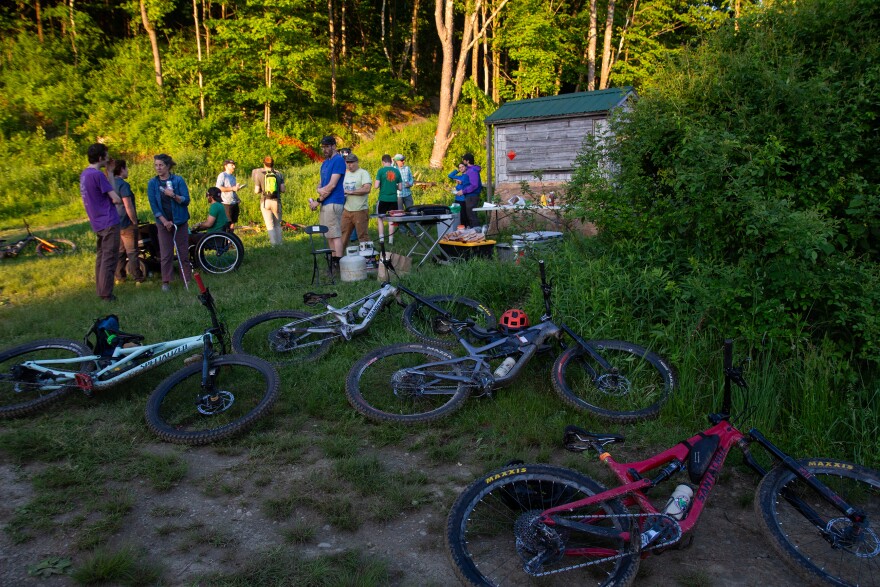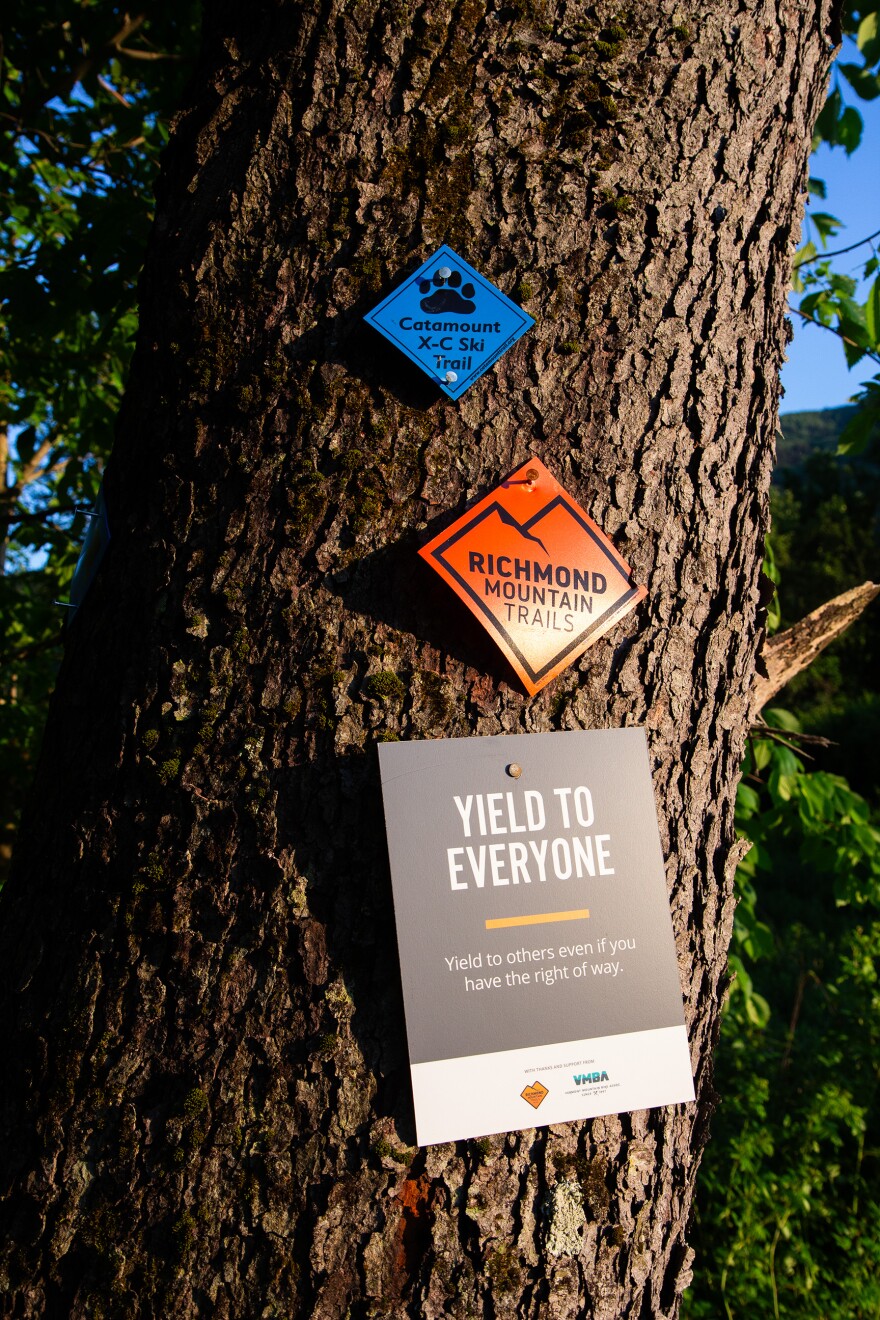One recent summery evening, as the sun turns gold and the flies grow more persistent, a bunch of people park their cars in a field in Bolton, and pull out their mountain bikes.
Above this field is a hill covered in tall trees. And winding between those trees is a new trail network Tonight, volunteers are putting the final touches on the trails.
For that work, Greg Durso gets on his adaptive mountain bike. It looks like a trike, with three wheels.
鈥淭his is a prone-position bike, meaning I kneel, I have my chest on a chest plate, and my hands are out in front of me, so it's more head-first,鈥� he says.

First, Durso makes sure the motor battery pack is secured.
鈥淲hen it gets kind of like, bumpy or rocky out there, the battery can shift, and you can lose the power, and that鈥檚 not very fun,鈥� he says.
Durso throws on his sunglasses 鈥� to keep the bugs out of his eyes 鈥� before transferring from his wheelchair into the bike seat. He lifts each of his legs into the knee trays and tightens all the straps. Once he pulls on his elbow pads and gloves, and makes sure he has water, he鈥檚 ready to go.
He then bikes up the hill, stopping at one curve where several volunteers are whacking the ground with shovels. This has been a particularly wet spot, and now, it鈥檚 dried out.
鈥淭his is like, pretty impressive actually, I think it should be fine,鈥� Durso tells the volunteers, noting he can take the turn wide and cut his bike to the inside. 鈥淚 should be good.鈥�

Durso lives in Burlington and works for the , which empowers people like him, who have both spinal cord injuries and active lives. He got into mountain biking seven years ago, and says it鈥檚 become his favorite thing to do.
鈥淚 ride at Cady Hill a lot in Stowe, I think it's really fun there,鈥� Durso says. 鈥淜illington also works really, really well. Hinesburg Town Forest, another favorite of mine.鈥�
It was one ride in Hinesburg Town Forest several years ago that, according to Durso, proved a pivot point for adaptive mountain biking in Vermont. Also on that ride was Berne Broudy 鈥� she鈥檚 the president of the board for the
鈥淚 was on some really narrow bridges that looked pretty sketchy,鈥� Durso says.
And Broudy says at each of those bridges, the entire group would stop their ride.

鈥淧eople would get off their bikes, would help Greg across the bridge, which was maybe like, 6 inches too narrow for him to actually just make it on his own,鈥� she says.
And for Durso, he says, 鈥淚t was like, 鈥楬ey, like, this is great that this almost works. But like, it wouldn't be that crazy to actually make this work, right?鈥欌€�
Broudy notes that there are so many problems in the world that we can鈥檛 necessarily fix. But, she says, 鈥淲e can have an impact here. Like we can change this.鈥�

After that ride together, Durso and Broudy, along with a couple hundred volunteers, got to work. With the help of several nonprofits and 256 acres offered up by a Bolton landowner, they did something that鈥檚 never been done before in Vermont 鈥� and maybe in the country. They built the Driving Range trail network so it was fully accessible to adaptive mountain bikes.
鈥淲e don't know how to prove that, but we think it's the first,鈥� Broudy says.
They accomplished this by having Durso do what he鈥檚 doing tonight, and test-run every single trail.
鈥淚t's an honor for me just to be here and be part of this and build something that like, I know, like, actually has my hands on this,鈥� he says.
Durso says to have people counting on him 鈥� it鈥檚 something he doesn鈥檛 get to feel that often.
鈥淵eah it鈥檚 interesting like, I mean, I hate to get like, so cynical, but it's like, a lot of times you feel like a burden, right? There's these things that you just can't do, or like, it's hard,鈥� he says. 鈥淎nd I think you, you hide some of those feelings away.鈥�
But this dynamic is flipped at the Driving Range.
鈥淕reg is the most critical volunteer probably to this project,鈥� Broudy says. 鈥淏ecause every time we build something, like Greg rides it, gives us feedback, we fix it right away, he rides it again, and then we move on to the next spot. Like that is how we built this network.鈥�

And now that this network exists, Durso says it鈥檚 freeing to know he can show up here and access everything no problem.
鈥淧arking structure, handicap spots, there's a bathroom, like, right? It's all level and like, all those things like, easy, I can get there,鈥� he says. 鈥淎nd then I get on trail and all the trails I know work based upon your skill level.鈥�
To be clear, the trails at the Driving Range 鈥� they鈥檙e universally accessible to all mountain bikers. But they aren鈥檛 鈥� easy. I watch Durso fly down an incredibly steep hill. Then a few minutes later, he goes careening around a corner underneath a jump, where a series of younger bikers launch themselves a dozen feet in the air.
鈥淧eople think of adaptive mountain biking, and they think it鈥檚, they think ADA first, and it's kind of the exact opposite of what we're doing,鈥� Durso says. 鈥淭his is mountain biking, we still want the trails to be hard.鈥�
It鈥檚 mountain biking, and even more importantly for Durso, he says the Driving Range creates community. Once he finishes riding tonight, he joins the crowd gathering by the trailhead for a barbecue, where more prospective mountain bikers discuss what kind of adaptive equipment they might like to try.
鈥淭he bike riding is great, but this place transcends the riding, right? It becomes this identity or vibe, or whatever it is to you. And it's bringing so many adaptive people together to have that. And that's just so hard to actually articulate and provide,鈥� Durso says. 鈥淏ut it gives that sense of normalcy back to people that don't know what that feeling is anymore.鈥�
To have a place 鈥� a home 鈥� for adaptive riders to go at any time, he says, is really game changing.
And more adaptive-friendly mountain biking is coming online across the state. The Vermont Mountain Bike Association, in partnership with the Kelly Brush Foundation and Vermont Adaptive Ski and Sport, that are accessible to adaptive riders.
Have questions, comments or tips? .





